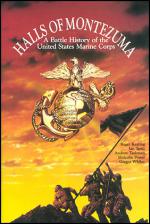
C&VG
 1st September 1988
1st September 1988
Author: Steve Badsey
Publisher: Strategic Studies Group
Machine: Commodore 64
Published in Computer & Video Games #83
Halls Of Montezuma
The Australians of SSG have gone all out for the American market with this "battle history of the United States Marine Corps" in eight scenarios. It judges the Marines by their own standards - they are almost as good as they think they are - but unlike some American games does not make them completely bullet-proof.
Using the same mechanisms as, and fully compatible with, their earlier games Battlefront and Battles In Normandy, this game follows the Marines from the assault on Mexico City in 1848 which gives the game its name (and the Marine Hymn its first line) through the taking of Belleau Wood in France in World War One, plus one scenario for Iwo Jima and two for Okinawa in World War Two, the Inchon landings and defence of Pusan in the Korean War, and the recapture of Hue citadel in Vietnam. In addition, as is now normal with SSG games, the disk contains a design section, which with SSG's Warplan and Warpaint routines already added allows you to edit every useful unit and terrain icon in the game and create any scenario you desire, down to the weather.
Why then, did I find myself thinking as I played Halls Of Montezuma, "Oh no, not again!"

Mainly because of the continuing awfulness of the SSG Battlefront style graphics. In land wargames, maps are absolutely crucial to understanding what is going on, where your own forces are and what the enemy if likely to do. The SSG hex-map does not show the whole battlefield properly and dissolves rather than scrolls, making it very difficult to read (and giving you an almighty headache). Any units shown on it move in a completely unrealistic way and are often not recognisable as either friend or enemy. The map actually gets in the way of the game.
If improving the graphics is a problem of computer memory then SSG would do better to scrap them altogether, letting the player rely on the printed maps that they supply with the game. This would produce something like an adventure game, with the player in his "command post" receiving reports on the battle from outside.
The Battlefront game mechanism used in Halls Of Montezuma produces a one or two player game in which each side's forces must be divided into up to three main units, but no more. This did not work well in Battles In Normandy and works even less well for these scenarios. Mexico City itself, the teaching scenario, is among those considerably altered from history to fit the game. (It was a surprise, commanding the North Koreans, to learn that the computer thought my forces were "The Axis"). But the game is not all bad. The method of selecting highlighted options and interrogating your forces down to two levels below your command, by far the best mechanism of the game, remains as good as ever.
What is worrying is that the earliest of the SSG games, the strategy games such as Reach For The Stars and Carriers Of War, remain, for me, by far their best. Operational land warfare requires a different games system, and far better graphics than this. On the other hand, if you liked Battlefront, then Halls Of Montezuma is for you.
Scores
Commodore 64 Version| Graphics | 30% |
| Sound | 80% |
| Value For Money | 70% |
| Playability | 70% |
| Overall | 60% |
Scores
Apple II Version| Graphics | 30% |
| Sound | 80% |
| Value For Money | 70% |
| Playability | 70% |
| Overall | 60% |





